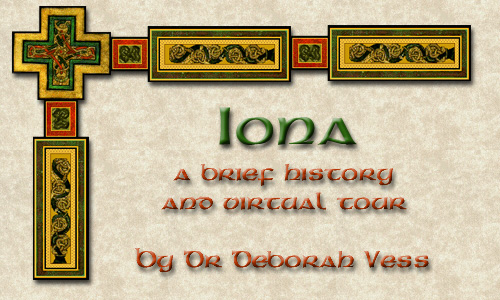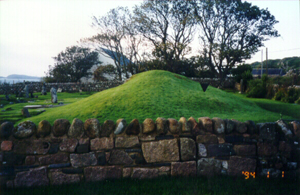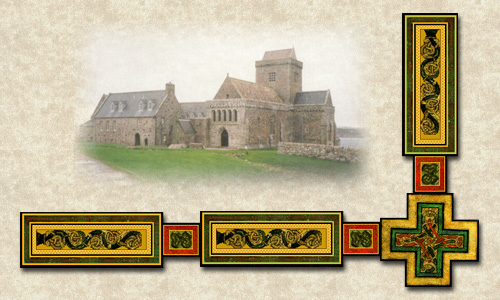 |
|
IntroductionThe name "Iona" has an uncertain origin, but it is derived in part, from the name of its most famous inhabitant, St. Columba. In Gaelic, the name of the island is I Chaluim Cille, meaning the "I of Colum cille (Columba's Latin name, which means "dove of the church"). The name "I" refers to the Celtic word for yew tree, which were common on the island. Columba's biographer Admoman referred the island as the Ioua insula (Latin for yewy island). Iona comes from a medieval misreading of Ioua. This mistake, however, was a natural one to make as it is the Hebrew word for dove, which refers to the Latin name for Columba.
Iona was an important center for pilgrimage in the Middle Ages and is still today, as one can see from the photo above. As you take a virtual pilgrimage to Iona here, it it is my hope that you too can feel the sacred nature of this island and be captivated by its spirituality.
Iona has always had a sense of mystery and sanctity about it. According to legend, many Lords of the Isles, forty-eight Scottish kings, eight Norweigian kings, and four Irish kings were buried here in the Relig Odhrain. An unsubstantiated tradition also holds that Duncan and Macbeth, who were immortalized by Shakespeare, are buried here. Iona was also an important center of Celtic Christianity and monasticism in the the Middle Ages. Celtic monks from Iona were instrumental in the conversion of the Scots and, after their arrival on Lindisfarne, of the Northumbrians.
|
|
This site is dedicated with love to the Benedictine Sisters of Mt. St. Scholastica, who modeled for me in so many ways the Benedictine life; especially to Sister Therese Elias, O.S.B. of Mt. St. Scholastica, Esther de Waal, Hereford, UK, and Father Marcus Losack, Ireland, who made my journey to Iona possible; and to Diane and Carrel, whose presence called me back to the larger picture, and to Betty, who made me laugh with her blue mother story. Thanks to all for special gifts received ... copyright © Dr. Deborah Vess 1999. All rights reserved. Photographs by Dr. Deborah Vess. Visitors to this site are welcome to use the photos and other information for educational purposes provided that user acknowledges the source. For further information regarding these materials, contact the author via e-mail: or by snail mail at: Dr.
Deborah Vess
Special thanks to Cathy G. Locks, my graduate assistant, for technical help. Her love of medieval history and modern computer technology inspired this beautiful Celtic template for us to look at. Isn't she talented? |
 Pilgrimage group walking through the Machair
on one of the weekly Wednesday pilgrimages led by the Iona community.
Pilgrims make an arduous six-hour trek to many of the sites you will
see here.
Pilgrimage group walking through the Machair
on one of the weekly Wednesday pilgrimages led by the Iona community.
Pilgrims make an arduous six-hour trek to many of the sites you will
see here. The Relig Odhrain, the hill where ancient
and mythical kings are believed to be buried.
The Relig Odhrain, the hill where ancient
and mythical kings are believed to be buried.

